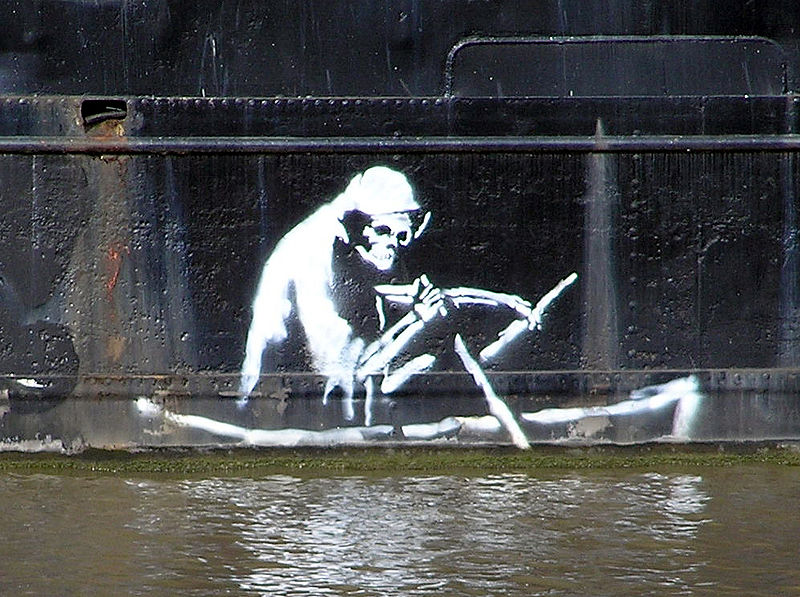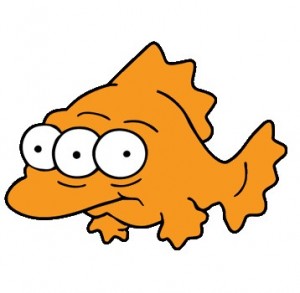This post first ran November 30, 2011.
Last week, I fell in the Thames. I only fell in up to my thighs, but the gaping, bleeding puncture on my shin, inside which I could see geologic-looking layers of anatomy — that was a bad sign.
So I found myself at the A&E (that’s ER to you, fellow ‘Mericans) at 4 in the morning in Hackney, where everyone was bored by my lack of gunshot wounds. Until, that is, I revealed that I’d taken a dip in the Thames. Then, even hardened nurses blanched and rushed off to confer with other medical professionals.
As the morning wore on and I kept seeing those expressions of pure horror every time I pointed at my leg and said the word “Thames,” I started to get pretty well creeped out. It culminated with the nice NHS doctor lady giving me my marching orders.
“If you see any red streaks, if you get any shooting pains in your leg, or anything feels wrong, come back immediately,” she advised, eyeing my bandage warily. “No one’s going to mind. Just tell them you’ve had your leg in the Thames.”
I started doing some Google-based investigation. Just what was so bad about inviting some Thames water into my gaping, bleeding flesh? My findings led me to conclude that my leg was either about to shrivel up and fall off, or spontaneously sprout 8 smaller legs. Or eyes.
 It all started in Victorian times, when the sewers of London just plain discharged into the Thames.
It all started in Victorian times, when the sewers of London just plain discharged into the Thames.
The river – which by the way was both the source of the city’s drinking water and the repository for all its poop – became choleric and pestilent. In the summer of 1858, the fumes became so bad they got a name. The “Great Stink” forced members of Parliament to write the legislation that gave the all-clear to Joseph Bazalgette, London’s chief engineer of public works, to build the two massive interceptor sewers that catch London’s sewage and run-off before they’re belched into the Thames. To this day, these brick and mortar Victorian artifacts comprise the backbone of London’s sewer system.
After that, the water began to clear up. Slowly.
“In 1878 a paddle steamer, the Princess Alice, collided with a cargo ship (Bywell Castle) and sank with 800 people on board. Over 600 died, with common rumours that many were overcome by the fumes from the polluted water before they could reach shore.”
But during World War II, the steady improvements fostered by Bazalgette’s system were swiftly undone by German bomb strikes, which collapsed water mains and sewer lines, clearing the way for sewage to flow into the Thames unmolested once again. In 1958, a neat century after the Great Stink had driven members of Parliament to legislate London’s hygiene, the Thames was declared biologically dead.
But it’s all better now! In the 1960s, 70s and 80s, the systems were rebuilt, and supposedly the Thames is now clean enough to comfortably house 120 species of fish.
Earlier this year, someone even found a seahorse. In fact, the Zoological Society of London, which monitors the Thames, now complains of invasive species, which strikes me as rather ungrateful.
All of this contributed to giving me an initial sense of security. And, earlier this year, an English comedian named David Walliams even took to the Thames for an 8-day, 140-mile charity swim. My sense of foreboding returned, however, when I read the proud assertion that the Thames is now “one of the cleanest major metropolitan rivers in the world,” a caveatted-to-death phrase that didn’t so much quiet my fear of the Thames as cause me to fear all rivers.
And sure enough, being [one of] the cleanest [major] [metropolitan] river[s] in the world does not mean it’s okay to take a dip in it. “The Thames is not a designated bathing area,” a Thames Water spokeswoman, who was almost certainly not doing a brilliant parody of dry British understatement, told the Independent after Walliams developed a troubling case of “Thames tummy”.
Thames tummy, which can be caused by ingesting big gulping mouthfuls of Thames water for eight long days, involves diarrhea, vomiting and fever while also not closing off the possibility of Legionnaires’ disease, salmonella, hepatitis, cryptosporidiosis, and Weil’s Disease.
That last one has sent me running to NetDoctor multiple times a day to feverishly check and double-check for symptoms.
That’s because getting Weil’s disease (pen name: leptospirosis) doesn’t require drinking a single drop. That nasty bacterial infection, most commonly transmitted by water that has been contaminated by animal urine, can enter the body through the eyes, the mucous membranes, and breaks in the skin. If the demonic little corkscrew-pasta — which were recently implicated in the death of an Olympic rower — were hanging out by the house boats near Vauxhall last Friday night, I was doomed.
Did I have it? The Guardian would tell me.
After an incubation period that can vary from three days to three weeks, most patients suffer severe headaches, red eyes, muscle pains, fatigue, nausea and a temperature of 39C or above. In roughly a third of cases there is a skin rash; sometimes hallucinations.
The only difference between Weil’s disease and science journalism is that Weil’s disease will lead to a horrific trifecta of meningitis, liver damage and finally renal failure.
So what are these evil corkscrews doing in the Thames?
The problem was that Bazalgette wasn’t thinking big enough. His diversion project was created for a city of 2.5 million – and even that number was almost unthinkable at the time. In 2011 , however, London’s population has swelled to 8 million, and the infrastructure is simply no longer up to the task. About 50 times a year, the sewers overflow and send enough sewage into the Thames to fill up a sporting arena once a month.
Walliams’ case of Thames tummy was seized upon by proponents of a plan to create a super sewer, which would be the first update of Bazalgette’s Victorian infrastructure since it was first built and will supposedly solve the overflow problem for 100 years.
The super sewer will take the form of a monster 24-mile pipeline running 75 meters beneath the Thames like a shadow river, diverting sewage overflows. That’s almost the length of the Channel tunnel, wide enough to accomodate three London-style double decker buses, and it’ll set us back a cool £3.6 billion by the time it’s complete in 2021.
Not everyone thinks it’s a good idea. Not all the Thames’ pollution comes from human poo, you see. Weil’s disease, which I have been frantically Googling several times a day, comes from rat urine. Unless they can figure out a way to divert London’s rats, both Walliams and I might be, uh, shit out of luck.
Photo credits
Banksy’s river art: Banksy’s image of Death is a reference to a 19th century illustration that immortalised the The Great Stink. Photo: Adrian Pingstone.
“A Monster Soup”: Wellcome Trust, Engraving by William Heath/ commonly called Thames Water by Wellcome Library / Wellcome Images and licensed under a Creative Commons Attribution 2.0 UK: England & Wales License.
Blinky the 3 eyed Simpsons fish: widely available on the internets

